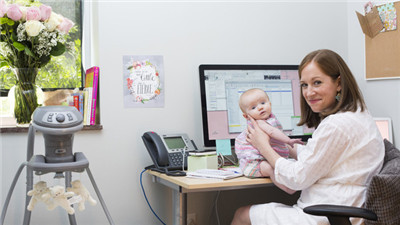Child’s play: Lauren Picarello, top, and Marshall Wright, above, both brought their babies to work at ad agency T3
带娃去上班:劳伦皮卡雷洛(Lauren Picarello,见上图)和马歇尔嘠禍(Marshall Wright,见左图)都把自己的宝宝带到他们工作的广告公司T3去上班
After a few months of practice, Marshall Wright found he became expert at coding with one hand and feeding his baby daughter Maggie a bottle of milk with the other. “We got into a good routine.. bonding and you’re doing your thing at work.”
经过几个月的练习,马歇尔嘠禍发现自己已经能够熟练地一手写代码,一手拿奶瓶喂他的小女儿玛吉喝奶了。“我们形成了一种良好的生活规律……孩子也带了,工作也做了。”

At that time — 2006 — Mr Wright, then a software engineer at T3, a Texas-based advertising agency, was the first father to participate in its programme allowing staff to bring their infants to work every day for six months.
那是在2006年,赖特是位于德克萨斯州的T3公司的一名软件工程师。当时,赖特是公司里首位参加允许员工连续6个月每天带宝宝上班的计划的父亲。
Gay Gaddis, the agency’s founder, initiated the scheme 20 years ago when four key employees became pregnant. “As a friend I was very happy for them. As an employer I was worried about losing them.” When she suggested it to the women, all first-time mothers, they were horrified that it could distract from their professionalism. “They were nervous about how the babies would behave,” says Ms Gaddis. But the four women agreed to give it a go after their three-month maternity leave finished.
这家广告公司的创始人盖伊加迪斯(Gay Gaddis) 20年前发起了这个计划,当时有4 名关键员工怀孕了。“作为朋友,我为她们感到高兴。作为雇主,我担心会失去她们。”这4名员工都是初次做妈妈,当加迪斯向她们提出这个建议时,她们都十分害怕这会使她们无法专注于工作。“她们很担心宝宝们会不乖,”加迪斯说。但这4名女士都同意在3个月的产假结束后试一试。
Almost 90 babies have regularly gurgled alongside their working parents. Typically, they come at three months (when the company’s paid maternity leave ends) and leave at nine months, or as soon as the child can crawl.
已经有近90个宝宝经常被父母带去上班。通常,他们在3个月大的时候(公司的带薪产假结束的时候)来,在9个月大时,或者一学会爬的时候就离开。
Mr Wright was nervous ahead of taking Maggie to the office after his wife’s maternity leave ended. However, he says, colleagues cut him some slack. “It was recognised that I wouldn’t be working at 100 per cent but that was OK.”
妻子的产假结束后,赖特打算带玛吉去上班,当时他有些紧张。不过,他表示,同事们很通融。“大家明白我不会百分之百地投入工作,但这没关系。”
Ms Gaddis, a mother of three, is re about such parents’ reduced productivity. “This time is not all that long in the scheme of things. If the baby was at day care they might also be distract .” Mr Wright says his greatest critic was probably himself: “You put more pressure on yourself than others will.”
加迪斯是3个孩子的母亲,她对于这些父母工作效率降低一事并不忧虑。“一般来说,这段时间并不是那么长。如果婴儿在日托所,他们或许也会分心。”赖特表示,他最严厉的批评者或许就是他自己:“比起其他人,你给自己的压力更大。”
For Lauren Picarello, T3’s director of brand and business development, who started bringing her baby in to work this month, the scheme helps “foster more collaboration across teams”.
劳伦皮卡雷洛是T3品牌和业务发展总监。她从这个月开始将自己的宝宝带来公司。她表示,该计划有助于“促进团队合作。”
At other companies, such as WS Badger, the natural bodycare products maker, the working day incorporates two unpaid hours in total when the parents can focus entirely on their infant.
在其他公司,比如天然护肤品制造商WS Badger,每个工作日都包含无报酬的两小时,父母可以在这段时间里全心照管自己的宝宝。
The relative popularity of such initiatives in the US, says Brad Harrington, executive director of the Boston College Center for Work & Family, is a sign that some companies are trying to address the government’s failure to guarantee paid maternity or paternity leave. He points to this week’s announcement by Netflix that it will allow up to a year’s leave to new parents as another example of companies taking the initiative.
波士顿学院(Boston College)工作与家庭中心(Center for Work & Family)执行主任布拉德哈林顿(Brad Harrington)表示,这些举措在美国更受欢迎,表明一些企业试图解决政府未能确保带薪产假或者陪产假的问题。作为主动采取措施的企业的又一个例子,他提及Netflix,该公司近日宣布将为新晋为父母的员工提供长达1年的假期。
Giving parents responsibility for their babies is also cheaper and less bureaucratic for a company than setting up on-site childcare facilities.
对企业来说,让员工自行承担起照顾孩子的责任,比在公司里设立托儿所花费更少,也更人性化。











